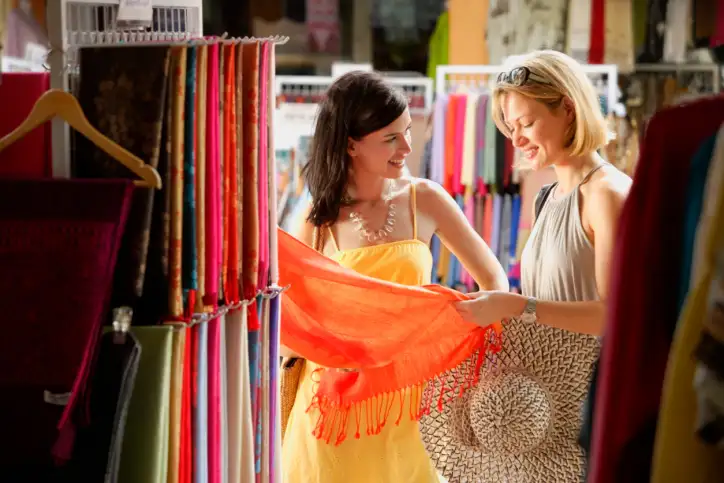
At Europe’s lively open-air markets and bazaars, bargaining for merchandise is the accepted and expected method of setting a price. Whether you are looking for door knockers or hand-knitted sweaters, seize the chance to bargain like a native. It’s the only way to find a compromise between the wishful thinking of the seller and the souvenir lust of the tourist.
Bargaining can be fun if you learn how to haggle. Among many good markets to practice your skills are Amsterdam’s Waterlooplein, London’s Portobello Market, Paris’ Puces St. Ouen, Madrid’s El Rastro, and Tangier’s Souk. Caution: Pickpockets enjoy flea markets as much as you do—wear your money belt.
When browsing, first determine if bargaining is appropriate. It’s bad shopping etiquette to “make an offer” for a tweed hat in a London department store. It’s foolish not to at a Greek outdoor market. In Venice, walk away from knock-off goods; the sellers and even the buyers are subject to fines.
To learn if a price is fixed, show some interest in an item, but say, “It’s just too much money.” You’ve put the merchant in a position to make the first offer. If he comes down even two percent, there’s nothing sacred about the price tag. Haggle away.
Snoop around and find out what locals pay. Prices can vary drastically among vendors at the same flea market. If prices aren’t posted, assume there’s a double price standard: one for locals and one for you. I remember thinking I did well in Madrid’s flea market, until I learned my Spanish friend bought the same shirt for 30 percent less.
To avoid a bad case of buyer’s remorse, decide what an item is worth to you before beginning to haggle. Many tourists think that if they can cut a price by 50 percent they are doing great. So the merchant quadruples his prices, and the tourist happily pays double the fair value. The best way to deal with crazy price tags is to ignore them. In determining the item’s value to you, consider the hassles involved in packing it or shipping it home. (If a merchant ships an item home for you, remember to have a picture taken of yourself with the item and merchant; it will help you get the item replaced in case it arrives in pieces.)
When you’re interested in an item, look indifferent. As soon as the merchant perceives the “I gotta have that!” in you, you’ll never get the best price. He assumes Americans have the money to buy what they really want. Your job is to determine the merchant’s lowest price. Many merchants will settle for a small profit rather than lose the sale entirely. Promise yourself that no matter how exciting the price becomes, you won’t buy. Work the cost down to rock bottom, and then walk away. That last price the vendor hollers out as you turn the corner is likely the best price you’ll get.
Work as a team with your spouse or a friend. While you bargain, your companion can act the part of naysayer, threatening to squash the deal entirely. This trick can work to bring the price down faster.
Study ahead, especially if you want to buy something more substantial like a leather coat or a big-ticket item like a Turkish carpet. Istanbul has very good leather coats for a fraction of the US cost. Before my trip I talked to some leather-coat sellers and was much better prepared to confidently pick out a good coat in Istanbul’s bazaar.
Obey the rules. Don’t hurry. Bargaining is rarely rushed. Show you are serious by taking the time to talk with the shopkeeper. Dealing directly with the owner can lower the price (no sales commission).
If you are truly ready to buy, show the merchant your money. Physically hold out the amount you are offering to pay for whatever you are bickering over. The seller will be tempted to just grab your money and say, “OK.”
Prices can drop at the end of the day, when merchants are starting to pack up. Swoop in at closing time to snap up the real deals.
If the price is too much, move on. Never worry about having taken too much of the merchant’s time. Vendors are experts at making the tourist feel guilty for not buying. It’s all part of the game. Most merchants, by local standards, are financially well-off.
It’s true that you might find the same souvenirs in a large department store, with a firm price. But where’s the fun in that? Store shopping can be quicker and easier—but it’s never as memorable.
Rick Steves (www.ricksteves.com) writes European travel guidebooks and hosts travel shows on public television and public radio. Email him at rick@ricksteves.com and follow his blog on Facebook.
We hand-pick everything we recommend and select items through testing and reviews. Some products are sent to us free of charge with no incentive to offer a favorable review. We offer our unbiased opinions and do not accept compensation to review products. All items are in stock and prices are accurate at the time of publication. If you buy something through our links, we may earn a commission.
Related
Top Fares From Columbus, OH
Today's Top Travel Deals
Brought to you by ShermansTravel
Shop and Save with Country Inns...
Patricia Magaña
 Hotel & Lodging Deals
Hotel & Lodging Deals
$229 -- Chicago: Discounted Rates and...
Francesca Miele
 Hotel & Lodging Deals
$229+
Hotel & Lodging Deals
$229+
$188 -- Honolulu: Save on Oceanview...
Abigail Lamay
 Hotel & Lodging Deals
$188+
Hotel & Lodging Deals
$188+



